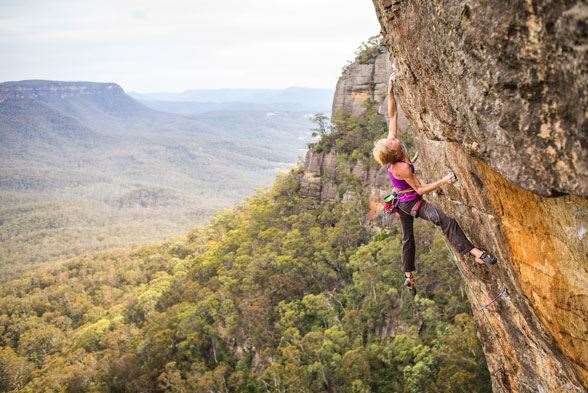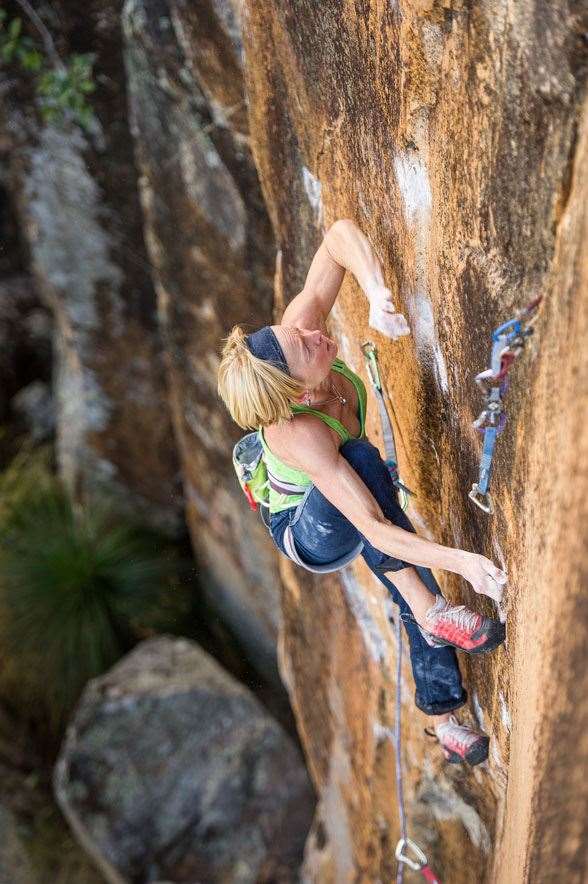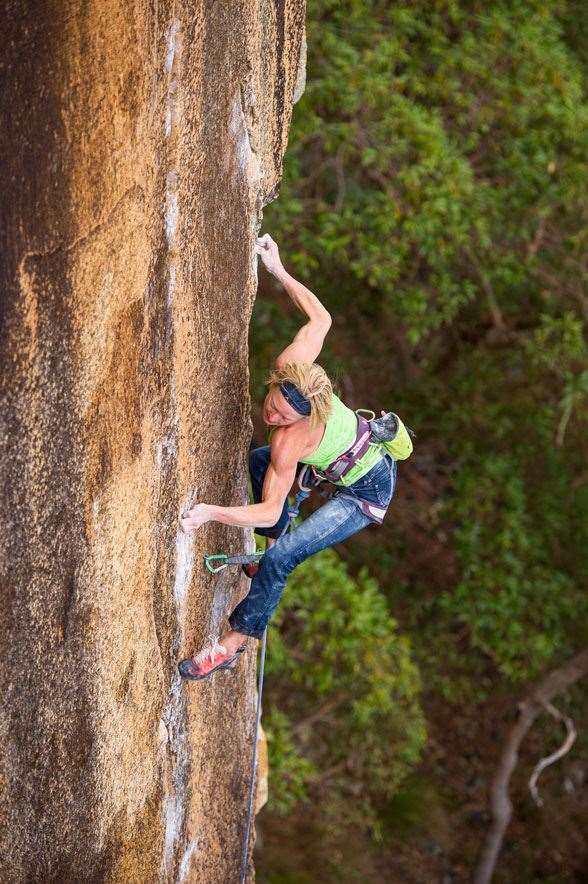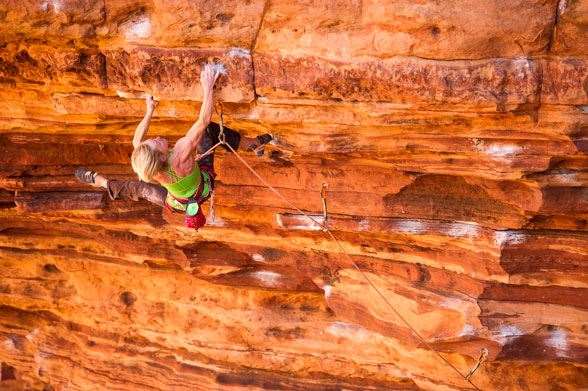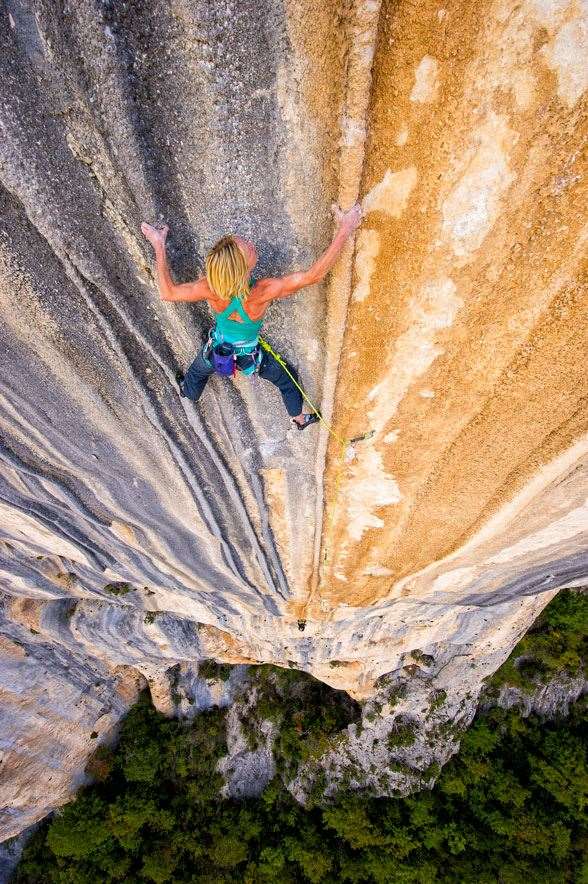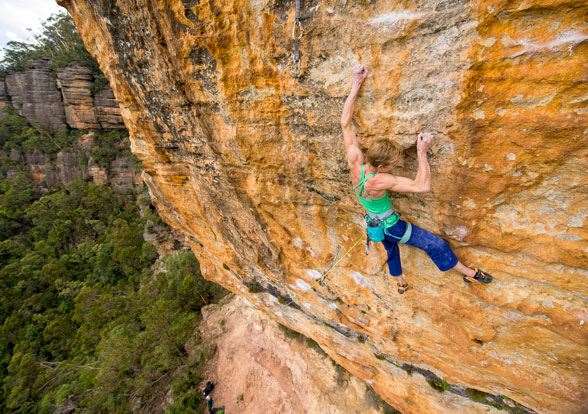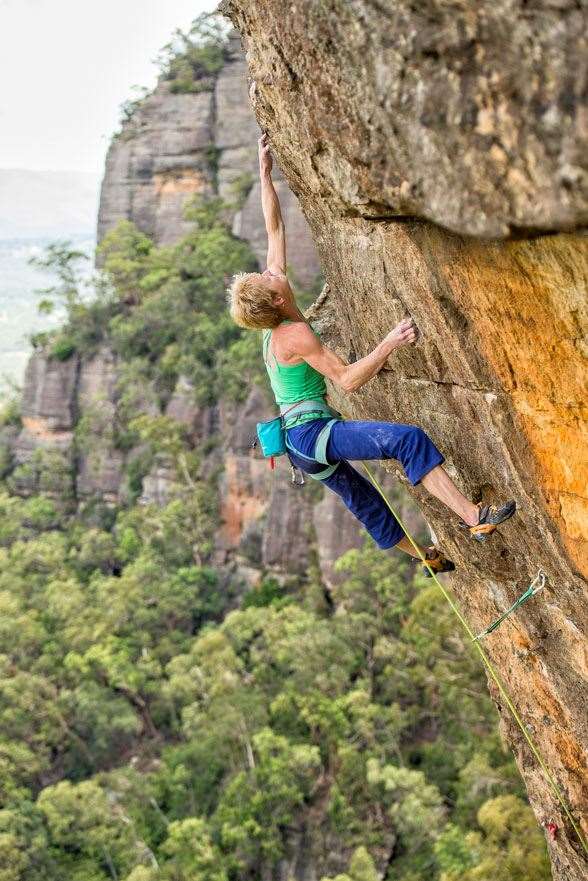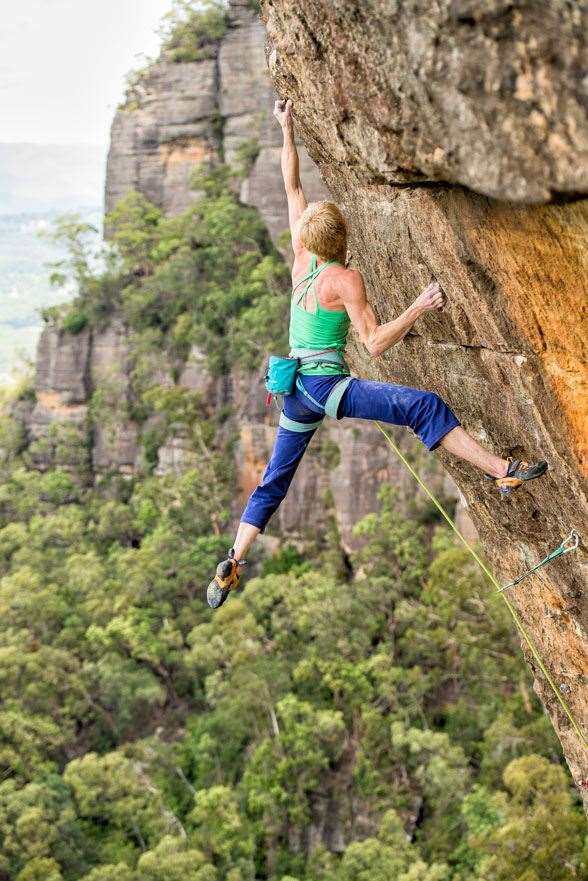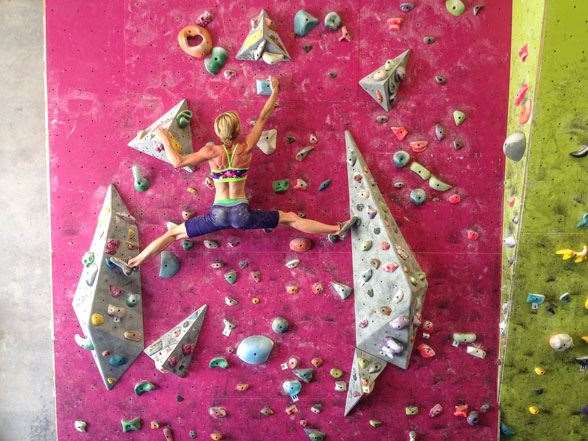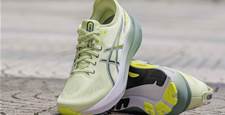How to train like a champion rock climber.
On December 27 last year, news filtered through the Australian rock climbing fraternity that Monique Forestier had finally conquered the route called Tiger Cat (grade 33) in the NSW Blue Mountains after two years of trying. In the arcane world of rock climbing, this was what you’d call a peak experience. It meant she was the first Australian woman to twice climb routes graded 33. To put the achievement into some perspective, the hardest route climbed by an Australian male is grade 34. Forestier is 41, the mother of a five-year-old, and still (obviously) climbing at the very top level. The route Tiger Cat (pictured opposite) is located at a cliff called Elphinstone; it is 35 metres long, overhangs by about 12 metres, and has three main “crux” sections – with the last crux coming right at the top of the climb. Forestier fell from here many times as she matched wits with the rock. Until the last time. Forestier occasionally competes in indoor climbing and bouldering competitions around the country, and has travelled extensively to tackle hard rock climbs around the world, including Madagascar, China, Vietnam, Borneo, USA and Spain. She writes about her exploits in her blog (www.moniqueclimbs.com.au) and particularly loves conducting coaching clinics. She tells us how she does it. Her husband, renowned climbing photographer Simon Carter, provides the images.
BEGINNINGS
“I was always a very active child, very energetic. As a child I was an elite gymnast, doing artistic gymnastics to a national level – beam, bar, floor and vault. I trained at the State Sports Centre at Homebush. It wasn’t the AIS, but the next highest level. I thrived on the training itself – but I found I was getting scared of landing on my head by not performing skills correctly. I wasn’t one of the best in the group, so I probably didn’t get the amount of coaching attention I needed at that point to get over some hurdles. But it led me to give up gymnastics at 14. I then took up performance acrobatics for several years. It was mixed pairs – I had a male partner. We did incredibly well, also getting through to national level. But I stopped gymnastics when I began pursuing my studies. That meant there was something vacant in my life – I could only do swimming and indoor soccer while I was studying at university. As soon as I finished I sought other forms of fitness. And climbing kind of landed in my lap – I was given a free pass to an indoor climbing gym. Right from the get-go I was hooked. I knew I had found something I could just take to a higher level – like a personal goal. I like pushing myself personally, physically and mentally, and climbing ticks all those boxes. The rest is history. So I started off indoor once a week, then twice, then three times ... and I made friends and they said, ‘Why don’t you come outdoors?’”
RISK AND REWARD
“At the start I was frustrated because everything was so much slower than in the gym. There was so much to learn to be able to be a safe, confident leader on rock. And I just wanted to climb a LOT. I was frustrated because I couldn’t shortcut the process. My patience was tested. But I loved it. Sure, there is a risk there in climbing, but it can be contained and minimised, because we practise certain safety measures. Firstly we use a rope and protective gear, and we have ways in which we fall. We minimise and manage the risk. I’ve said it before: gymnastics made me scared, but climbing gives me courage.”
TRAINING TIME
“My weekly training regimen depends on what I’m climbing at that time. Right now I regularly do two sessions of strength training, at least two sessions of cardio, and two sessions of stretching. Then I do two to four climbing sessions, depending on intensity and what time is available. For my weight training, I have a circuit. I’m doing chin-ups unassisted with a weight belt until failure. Then I’m doing lat pulldowns on a machine but the arms are independent so it simulates climbing more closely; that’s again to failure at a weight where I can do eight to ten reps. I also do a thing underneath a bar and put my feet on a Swiss ball. And then I do pull-ups under a bar but hold it for two seconds at the top, so it’s like lock-off training, and I do that to failure. Then I do bench press with a 25kg bar to failure. I also do sumo squats, which are a leg exercise. And then I do this physio exercise up against a wall to strengthen the stabilising muscles in my shoulder. For cardio, I run, swim or row. It averages about 40 minutes per session. I have a few different running circuits up here in the Blue Mountains. For my swimming I generally do a mile, which is 32 laps in a pool. But if I’ve coupled it with a run I might only do a kilometre. And for the rowing I do ten minutes – five minutes’ warm-up then intervals for five minutes. That’s my warm-up before I do my weights program. At home I have a fingerboard training system. It’s on my training wall at home. It isolates each grip: two-finger pocket, front two, middle two, the back two, open hand, crimp and pinch. And you exercise each of those to failure, and as you progress you put on a weight belt. It’s very strict. You do a maximum of 24 moves, you rest for three minutes, then you do it again, then you rest for three minutes, then you change the hand grip, then you start it all over again. I don’t push myself to the utmost limit on that one because I don’t believe in completely annihilating my finger tendons.”
TAMING THE TIGER
“When you look at climbing something like Tiger Cat, it’s like rehearsing a gymnastics floor routine at the highest level. You have it all rehearsed – you have sequences dialled. You know exactly what you’re doing next and what’s coming up. Not everyone makes a climb using the same movements. Everyone has to work out their own ways up sections because of our different body shapes and strengths and weaknesses, particularly with length and reach and height. Taller people might not need to use so many smaller holds because they can reach through sequences, but they might have difficulty elsewhere where the holds are closer together, whereas I can use my flexibility as an advantage. I attempted Tiger Cat on and off over two years. But I wasn’t climbing it all that time. I started after my Spain trip in 2013. And I progressed on it very quickly; after six or seven days I was getting close to the top before falling off. But then I hurt my knee. There’s a very deep heel hook rockover; when I tried to make the move the tendons in my knee got caught; the lower tendons flicked around my knee bone and created quite a bad injury. It was more a shock than a sprain – I heard a popping sound and I thought, ‘Oh god, what have I done?’ I didn’t know if I could walk out. It wasn’t something I needed surgery for but I did need to take time off to monitor it. After that I could never trust that knee on that move again, so I actually had to come up with a different sequence. I thought my chances on that route were finished because that was the only way that I could do that move. But I discovered on my next time on the route that there was another way and that’s the way I ended up doing it.”
IN THE MIND
“I consider a lot of things when I’m not on the rock – I do a lot of visualisation. I rehearse the moves in my mind and I get them down pat so I know exactly what’s coming up and what I need to do so I can get a rhythm to my climbing. But if I’m having trouble on a specific part of a route or I just want to refine something, I go through it in my mind and think about the rock and what other possibilities could be there. You can’t remember every single feature of the rock, but you can certainly come up with different options for a foot or a hand-hold. So when I hurt my knee I went back to the cliff and looked at the rock – and I thought perhaps there might be a little variation out to the left that I could do, and there certainly was. I swapped my left and right hand-holds to go one move further out to the left, and then I gained a left-hand side pull, and I used different feet, and I got another hold up higher with my right hand rather than my left hand. So I was just one notch to the left but I was still able to come back into sequence on the route. It was a real relief because I’d thought my chances on the route were gone, or I’d have to psychologically toughen up to do the move again that had injured me. But I was pretty relieved. I knew I had to be rested for two days prior to attempting the route. I’d had a finger injury which pretty much put me out for the year before, and it meant I couldn’t commit to this one move where I had to dead point to a really small hold – that’s a movement with momentum, where the end point is at the height of the movement. I couldn’t commit to that so I did actually find another sequence and a different way around that move.”
INJURY TIME
“Climbers are almost always dealing with injuries to shoulders or finger tendons. Because I had a finger tendon injury I went to the gym too much and developed a tendonosis. It’s on the outside of the elbow. Yep, climbers also get tendonitis, which is the inside of the elbow. But this was quite hard to shake. You have to rest – but some of us get a bit too impatient! I was actually very lucky to be born with hyper-mobility, but it hasn’t helped me with my shoulders in climbing – it’s actually worked against me because I’ve subluxed both my shoulders. Subluxation is when the joint partially comes out of the socket. I’ve had to work very hard to build muscle mass to improve that area to prevent that from happening again. The other injury I’ve had is brachial plexus neuritis. It’s a nerve bundle that comes out of your cervical spine and it spreads over the back of your shoulder girdle and down into your arms. I don’t know what triggers it, but it affects this nerve bundle. Depending on its severity I have different side-effects.”
DIET
“I’m incredibly lucky because I was born skinny, if you know what I mean. I’m not the type to put on weight. But I do watch what I eat. I don’t stay this way by eating fast food and drinking soft drink! I have healthy foods. Certainly when I’m doing power phases or training phases I make sure I have instant protein available straight after training or at the cliff – protein shakes. They’re usually loaded with BCAAs (branch chain amino acids) and some type of recovery compound. I also take a lot of supplements – Vitamin B, magnesium for muscle maintenance, Vitamin D for hair, skin and nails, Vitamin C occasionally. Then on and off I will mix in krill oil or Q10 or spirolina or those other types of things.”
SEEK MEDICAL ADVICE
“When I was trying Tiger Cat I was seeing a chiropractor at least once a week or once a fortnight. That’s to keep my back in line, and there’s one rib that keeps popping out of place from pulling really hard. He also does this really deep massage on my forearms. And he’s the one who fixed my knee. For a whole year after I injured it I was walking around with it slightly out of place; one day I mentioned it to him and he did this really deep massage on it for two sessions and ever since it’s never been better. He is fantastic. When I had the tendonosis I sought advice from an acupuncturist, but I don’t know how much that worked. I certainly gave it a try. And lately I’ve had a few massages in my down time to iron out the creases and get those knots out. I always tape my fingers when I’m out climbing, but that’s mainly due to skin conditions – I might have some splits or skin separation on my fingertips. Contact with the rock can create holes or your skin can dry out and create a split line along the crease. Or the other reason: when I was trying Tiger Cat, for the last move there’s a throw move. It’s a left hand throw to catch a very sharp pinch. When I was attempting it I would tape my left index finger in a very specific spot so I could psychologically go for the move – otherwise it tears it to shreds.”
NEXT?
“I’m pretty excited. I have plans to attempt a route called Silbergeier in Switzerland – it’s graded 32. It’s six pitches long – about 260 metres. And the crux is the fifth pitch, which is the 32. I’ve never attempted a multi-pitch this hard but it’s a route that has been in my mind for many years – ever since I started climbing. It was so far out of reach when I started climbing, but I’ve learnt to re-evaluate my goals. And the opportunity has come up so I’m going to give it a shot. I’ll be leaving mid-June and hopefully be over there for a month, but it depends a lot on the weather because it’s set in the high Swiss Alps. We could get a month of rain and not be able to get on the route ... so I’ve got no expectations. I’m just really happy for the opportunity to try this route. We work hard and we play hard. This is play.”
– Graem Sims
Related Articles
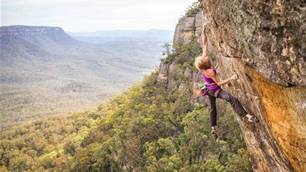
Climber Monique Forestier finally conquers the Tiger Cat

How Australia's beach volleyball women train

